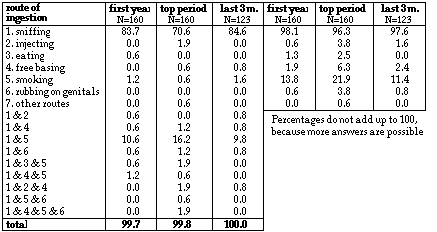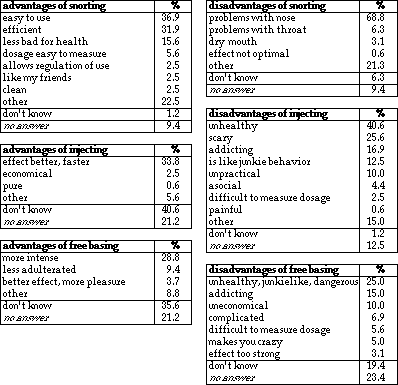Cohen, Peter (1989),
Cocaine use in Amsterdam in non-deviant subcultures. In: Peter Cohen (1990),
Drugs as a social construct. Dissertation. Amsterdam, Universiteit
van Amsterdam. pp. 106-109.
© Copyright 1990 Peter Cohen.
All rights reserved.
5. Routes of ingestion
Peter Cohen
- 5.1 - Introduction
- 5.2 - Prevalence of different routes of ingestion
- 5.3 - Route of ingestion in the three periods of use
- 5.4 - Advantages and disadvantages of the various routes of ingestion
Table of contents
5.1 Introduction
Cocaine can be administered via various routes of ingestion, each having its own attraction for different groups of users. Reasons for differential popularity of routes of ingestion are many, and in this chapter we will look into differentiations in routes of ingestion and the advantages and disadvantages that are ascribed to each of them.
5.2 Prevalence of different routes of ingestion
In Table 5.2.a we present the relative frequencies of six routes of ingestion, both in terms of life time prevalence ('Did you ever...') and in terms of last month prevalence. The six routes of ingestion we questioned our respondents about were: eating, rubbing on genitals, smoking, snorting or intranasal use (i.n.), injecting or intravenous use (i.v.), and free basing. Crack, an in the U.S. (rarely) used ready made free base product for smoking cocaine (Inciardi, 1987; Reinarman and Levine, 1988), had not appeared in our population during the time of interviewing from February through April 1987.
From Table 5.2.a it appears, that intranasal use is the dominating route of ingestion in this population. Both in terms of life time prevalence and in last month prevalence it ranks number one. The rank order of rubbing on genitals and i.v. use are reversed in the last month prevalence category, but cells are so small here, that this is insignificant.
Clearly i.n. use and i.v. use are on opposite sides of the popularity scale. Only 6.2% of the respondents have ever used a needle to administer cocaine.
In spite of the free availability in Amsterdam of all drug paraphernalia (plus reasonable quality cocaine[1] to produce cocaine base for free basing), only 18.1% of the respondents have ever free based. Last month prevalence of 2.8% is negligible.
Table 5.2.a Lifetime prevalence and frequency of different routes of ingestion, in %

Table 5.2.b Last month prevalence and frequency of different routes of ingestion, in %

5.3 Route of ingestion in the three periods of use
Respondents were shown a card with six different routes of ingestion: sniffing, injecting, eating, rubbing on genitals, free basing and smoking. They were asked to mention all routes of administering they practiced during the initial year of use, period of heaviest use and last three months. See Table 5.3.a.
Injecting and rubbing on genitals were rarely mentioned. In fact, some people remarked they did not know this latter way of administering cocaine, indicating they at least learned something from the interview. The left part of Table 5.3.a shows that the period of heaviest use is also the period in which almost 30% of the respondents used other methods (beside snorting). During the initial year and during the last three months this percentage is not higher than ca. 16%. The most often used method beside snorting is smoking cocaine in a cigarette. In the Amsterdam sample more differentiation in routes of ingestion is found than in Toronto, where free basing was completely absent. In Toronto 5% reported injecting the drug and 2% smoking.
The Miami sample of treatment clients and community based respondents contained 29% who always injected or freebased, 43% who always snorted and the remaining 28% who combined snorting with injecting or free basing or both.
Table 5.3.a Route of ingestion at three measuring points, in % (both exclusive and non exclusive)

5.4 Advantages and disadvantages of the various routes of ingestion
Of the three most well known routes of ingestion (snorting, injecting and free basing) respondents were asked to list advantages and disadvantages.The number of people giving advantages and disadvantages on injecting and free basing is larger than the number that had actually tried these routes of administration. Clearly, these respondents do not speak from their own direct experience.
Opinions can be interpreted as the equivalent of certain rules of use. From this perspective, rules of use might be the balance (or net outcome) of perceived advantages and disadvantages, irrespective of the factual correctness of these perceptions. Probably, the perceived net merit of each route of ingestion is a construction, made out of a mix of perceived effects of the drug on self or significant others, and social conventions about specific routes of ingestion. In this case social conventions could very well be related to the status of user groups that are especially associated with injecting and free basing. In table 5.4.a. we see that the most frequent route of ingestion in our sample, snorting, is the only one with more listed advantages than disadvantages. Mentioned disadvantages are plentiful for those routes of administration our respondents have had little or no experience with. In some of the disadvantages we recognize the negative connotations some user groups have. The relative absence of injecting and free basing among our respondents shows how strongly opinions about the disadvantages of these routes rule respondents' behaviour.
Freebasing and injecting are associated with antisocial and dangerous behaviour, probably junkie type drug use. Of these two negatively rated routes of administering, injecting is seen as the worst. The bottom position of injecting in respect to advantages is matched by its lifetime prevalence. Also, Morningstar and Chitwood (1983 p.311) find this strong negative connotation of injecting as a route of ingestion.
Some of the negative connotations that our respondents give to injecting are also found for free basing, but less frequently.
Table 5.4.a Advantages and disadvantages of sniffing, injecting and free basing, in % (N=160)[2]

